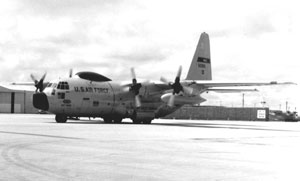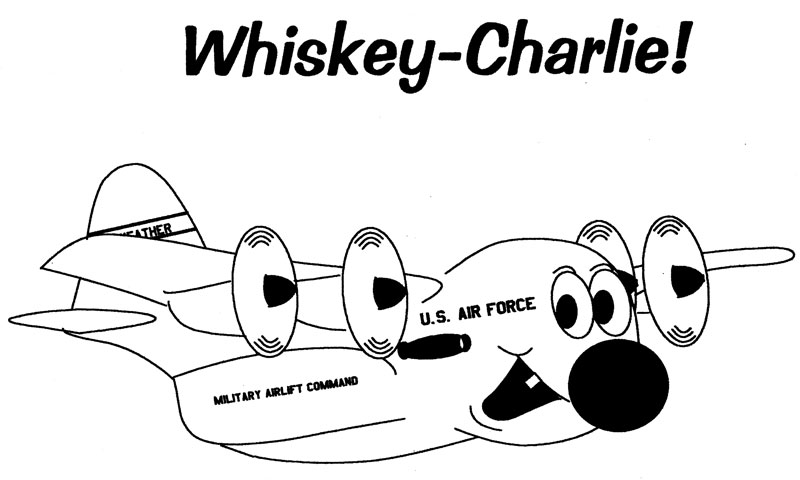
by Tom Robison
|
"In
the eye of a hurricane, you learn things
other than of a scientific nature. You feel the puniness of man and his
works. If a true
definition of humility is ever written, it might well be written in the
eye of a
hurricane." Edward R. Murrow, speaking
aboard a WB-29, in the
eye of Hurricane Edna, 10 Oct 1954 ~ ~ ~ ~ ~ ~ ~ ~ ~ ~ ~ U.S. Air Force aerial weather reconnaissance began a new era in 1962 when the Air Weather Service received its first Lockheed WC-130 Hercules. Over the intervening years, the Air Force and Air Force Reserve has operated 50 WC-130s: Three A-models, 17 B-models, six E-models, 15 H-models, and ten new J-models. 11 WC-130s have served all over the world, from the jungles of Southeast Asia to the forests of central Europe, from the islands of the Caribbean and the South Pacific to far above the Arctic Circle, from Japan to the Azores to Australia to the West Indies to China to the Middle East. The primary mission of the WC-130 has been that of tropical storm reconnaissance, but there have been other, no less demanding operations, such as atmospheric sampling1, rain-making5, fog-seeding 9, winter storm reconnaissance, and the air-drop of Christmas gifts. They have suffered the pounding of torrential rain, gut-wrenching turbulence, and the indignity of battle damage. They have carried their crews through the boredom of synoptic reconnaissance and into the intense snow squalls of the worst winter nor'easter. This
is a meager attempt to chronicle the history of these aircraft. They
are presented
here in the order that they were obtained by the Air Force. This
document is as accurate as I can make it using the published sources
available to
me. Comments, suggestions, additions and corrections are
encouraged. Contact the author at: herkynut@yahoo.com Last Revised: 28 January 2011 |
|
TABLE OF CONTENTS
1. THE FIRST B-MODELS 2. THE E-MODELS 3. THE A-MODELS 4. THE "NEW-OLD" B-MODELS 5. THE H-MODELS 6. THE J-MODELS 7. ABBREVIATIONS AND ACRONYMS 8. NOTES 9. SOURCES FOR WHISKEY-CHARLIE 10. ABOUT THE AUTHOR |
THE FIRST B-MODELS
| LOCKHEED C/N | USAF S/N | WHERE IS IT NOW? |
| 3702 | 62-3492 | Sold to Pakistan ca. 1985 |
| 3707 | 62-3493 | Hill AFB as a battle damage trainer |
| 3708 | 62-3494 | Sold to Pakistan ca. 1985; crashed 17 Aug 1988 |
| 3721 | 62-3495 | Sold to Tunisia, January 1998 |
| 3722 | 62-3496 | Sold to Turkey, Aug 1992 |
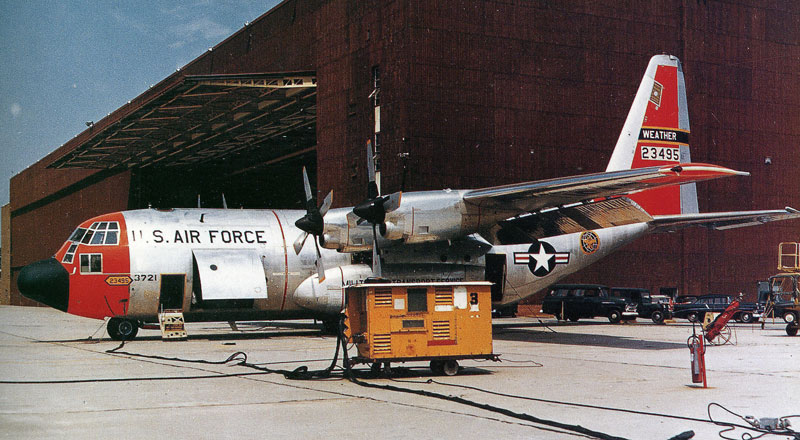 |
| WC-130B
62-3495 at WRAMA Photograph Courtesy of Lockheed, All Rights Reserved |
|
The C-130 had been coveted by the Air Weather Service since it was first introduced in 1955. It was the ideal long-range reconnaissance aircraft, and a perfect replacement for the aging WB-29s then in service. AWS was thus deeply disappointed in mid-1956 when it learned that the Air Staff had approved the transfer of 66 B-50 aircraft to AWS to be modified to WB-50. Even though AWS enjoyed a high priority due to its success at radiation sampling and hurricane reconnaissance with war-weary B-29s, the mission simply did not warrant the procurement of brand new aircraft. After a grueling and
deadly six years of operations with the WB-50, AWS was finally
granted authority to purchase five new C-130Bs, purpose-built at the
factory for
atmospheric sampling1. They were
delivered to the 55th WRS at McClellan AFB, California in October and
November of 1962,
and were immediately put to work flying daily reconnaissance tracks
across the Pacific. After a brief period
of OT&E, they were dispersed across
the Pacific, one each to the 54th, 56th, and 57th WRS’, with the 55th
keeping
two, one at McClellan, the other at Eielson. The five were modified for weather reconnaissance with the AN/AMR-1 Dropsonde Recording System2 at WRAMA in 1965 and were transferred to the 53rd WRS, then at Ramey AFB, Puerto Rico. The 53rd wasted no time in putting their new Herks to work, recording the first hurricane penetration by a WC-130 on 27 August of that year. (Since that time, the 53rd has logged thousands of hurricane penetrations with the WC-130B, E, H, & J without serious mishap.) All five B-models were again modified in 1970-71 under Project Seek Cloud3. 62-3492, which had become something of a guinea pig for the WC-130 fleet, was subsequently modified with the prototype Kaman Aerospace Advanced Weather Reconnaissance System4 (AWRS) in 1972. As delivered, these B-models were a natural aluminum finish with full color markings and "day-glo" red panels on the nose, upper wings, and tail surfaces. After modification in 1965, they were painted the standard MAC gloss gray, again with full-size color markings and a variety of MAC, AWS, and Squadron emblems and designations. They remained in this livery until conversion to transport. As a result of a number of HC-130H aircraft becoming available to AWS in 1972, the five original B-models were "traded in" and converted to standard transport versions. 62-3496 was converted in 1974, and -3493, -3494, and -3495 were converted in late 1976. 62-3492 remained a WC-130 until 1979, as she was the only Herk equipped with the AWRS. 62-3494 was sold to Pakistan in 1985. On 17 August 1988, this aircraft crashed shortly after takeoff from Bahawalpur Airport, killing the Pakistani president and several senior military officers. It is suspected that the aircraft was sabotaged or shot down by Pakistani dissidents. |
THE E-MODELS
| LOCKHEED C/N | USAF S/N | WHERE IS IT NOW? |
| 3659 | 61-2360 | Cut up for scrap, 2001 |
| 3688 | 61-2365 | Snow Aviation
Technology Demonstrator |
| 3706 | 61-2366 | AMARC, CF 146; no outer wings |
| 4047 | 64-0552 | Flying as CH-14 for Belgian AF |
| 4048 | 64-0553 | scrapped 3 Apr 2001; cockpit at SUAM |
| 4049 | 64-0554 | AMARC (ABDR), CF 136 |
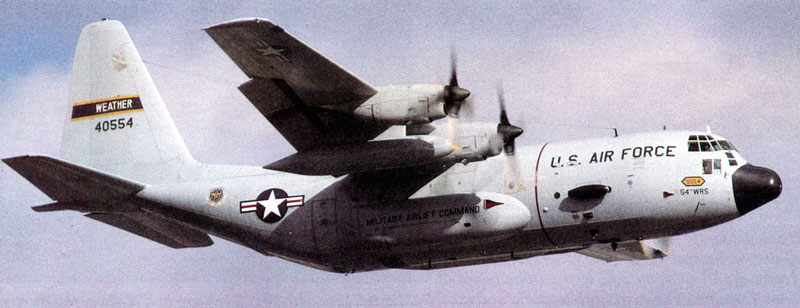 |
| WC-130E
64-0554 In-flight Photograph Courtesy Matsuoka, All Rights Reserved |
|
Having proven the worth of the C-130 as a sampling and reconnaissance platform, AWS asked for and received six more, in 1965. 61-2360, 61-2365, and 61-2366 were transferred from TAC, and 64-0552, 64-0553, and 64-0554 were brand new. They were modified for weather reconnaissance2 at WRAMA. All six were delivered to AWS in 1965, and transferred to the 54th WRS, Andersen AFB, Guam, that same year. In 1967 they were sent to Lockheed-Marietta for the addition of the atmospheric sampling system, and then returned to the 54th where they remained through mid-1972. For the following fifteen years all of them would transfer 'round and 'round amongst the 53rd, 54th, 55th and 56th squadrons, wherever the operational demand was greatest. After the 54th closed in 1987, all six Es were reunited at the 53rd WRS, then at Keesler AFB, Mississippi. In 1989, all the E-models were modified once again with the Improved Weather Reconnaissance System (IWRS)8 which had finally reached operational status after three years of testing and evaluation. At the same time, the atmospheric sampling infrastructure was removed from these aircraft, thus ending forever that capability of the WC-130. In 1991 the 53rd was deactivated, and all six Es were transferred to the 815th Weather Reconnaissance "Flight" of the 815th TAS, 403rd TAW, an Air Force Reserve unit at Keesler. (For a time the 815th Flight was designated as the 920th Weather Reconnaissance Group.) In 1993,
the 53rd WRS Hurricane Hunters were re-activated as an Air Force
Reserve
entity at Keesler, and assumed all weather reconnaissance duties,
aircraft, and personnel
from the 815th. At that time, four C-130H aircraft of the 815th AS,
which had previously
been WC-130s, were re-converted to the type, and the six E-models were
granted a
well-deserved retirement in the Arizona sunshine.
|
 |
|
As this is written, -2360 has been scrapped; -2365 has been modified to "C-130M" technology demonstrator by Snow Aviation in Columbus, Ohio; -2366 is apparently awaiting the grim reaper at Davis-Monthan; -0552 is owned by Evergreen Aviation in McMinnville, Oregon; -0553 was scrapped in 2001, but the cockpit portion is under restoration at the Southern Utah Air Museum; and, alas, 64-0554, shown above, is being used for Aircraft Battle Damage Repair (ABDR) training. This means she is being shot full of holes so that trainees can learn the intricacies of repairing battle damage. Ergo, my favorite Herk of all time is slowly and ignobly being reduced to scrap metal. She earned a better end." |
THE A-MODELS
| LOCKHEED C/N | USAF S/N | WHERE IS IT NOW? |
| 3127 | 56-0519 | Apparently still a derelict at Tan Son Nhut |
| 3130 | 56-0522 | Kelly AFB as a load trainer, IAAFA (no wings) |
| 3145 | 56-0537 | Broken up for parts at Marana, AZ, January 1999 |
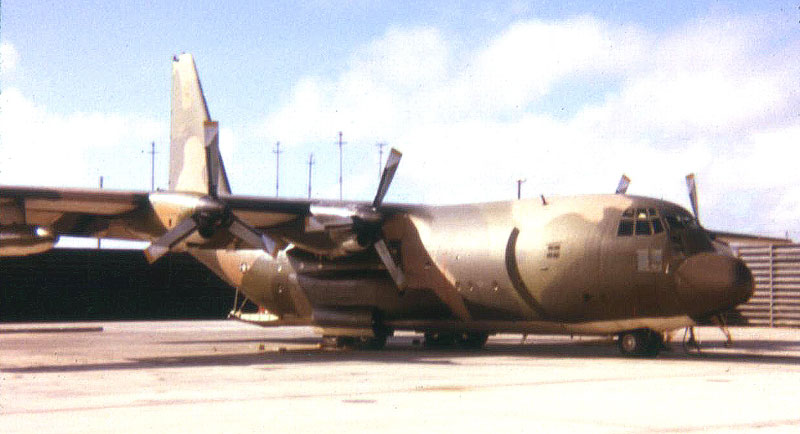 |
| WC-130A
56-0522 In a revetment at Andersen AFB, Guam in 1970 Photograph Courtesy of Tom Robison, All Rights Reserved |
|
Few aviation writers and historians seem to be aware that there were three WC-130As. These three were originally trash-haulers, borrowed from TAC in late 1966 for use in Operation "Popeye", the rain-making mission in Southeast Asia, set to begin the following year. The intent of the mission was to create enough year-round rain to keep the Ho Chi Minh trails impassable with mud5. Tests were conducted over Laos in 1966, and the operational missions began in March of 1967 from Udorn RTAFB, Thailand. They were flown by crews of the 54th WRS, rotated on a regular basis from Guam. In addition, 54th crews were sometimes called upon to conduct synoptic weather reconnaissance from Udorn over various areas of Southeast Asia, out to and including the Bay of Bengal. The A-models were modified for weather reconnaissance, probably at WRAMA, with the AN/AMR-1 system2. They were not configured for atmospheric sampling. Two were kept at Udorn, with the third rotating to and from Guam for maintenance, repair, and crew changes, from June 1967 through late 1970. When the third one was not enroute to/from Thailand, it was used for normal weather reconnaissance activities from Guam. In late 1970 the A's were replaced with three 1958 B-models, and the rain-making mission continued through mid-1972 with whichever B- or E-models were available from the 54th. After re-conversion to transport, the A's were transferred to Air Force Reserve units. During their brief stint as rain-makers, they flew a total of 1435 "combat" sorties, and it is reported that at least one of them received battle damage. All three A-models wore the standard Southeast Asia camouflage colors and markings, but with no unit designations of any kind. In 1973, 56-0519 was given or loaned to the South Vietnamese Air Force, and it became one of the spoils of war on April 30, 1975. The last reliable sighting was in April of 1999, which reported her corroded and derelict at Tan Son Nhut Airport, Ho Chi Minh City. |
THE "NEW-OLD" B-MODELS
| LOCKHEED C/N | USAF S/N | WHERE IS IT NOW? |
| 3520 | 58-0725 | Sold to the Philippine Air Force, 1995; retired 1997 |
| 3521 | 58-0726 | Sold to the Colombian Air Force, 1992 |
| 3524 | 58-0729 | Scrapped, 2002 |
| 3526 | 58-0731 | Sold to the South African Air Force, Oct 1997 |
| 3528 | 58-0733 | Sold to the Ecuadorian Air Force 1992, retired 1999 |
| 3530 | 58-0734 | Sold to the South African Air Force, Jan 1998 |
| 3537 | 58-0740 | Destroyed at Homestead AFB by Hurricane Andrew 6 |
| 3538 | 58-0741 | Sold to the Argentinean Air Force ca 1992 |
| 3539 | 58-0742 | Sold to Botswana, 1999 |
| 3545 | 58-0747 | Sold to the Philippine Air Force Sep 1997 |
| 3551 | 58-0752 | Sold to the Chilean Air force ca 1992 |
| 3559 | 58-0758 | Sold to Bolivia 1994; crashed Chimorre, 14Jan2000 |
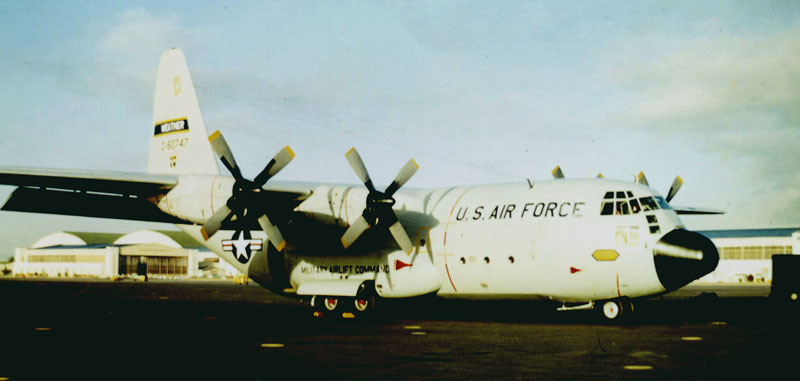 |
| WC-130B
58-0747 at Hickham AFB, Hawaii Photograph Courtesy of Tom Robison, All Rights Reserved |
|
Despite the damage and death caused by Hurricane Camille in 1969, there was one positive side-effect: she was a wake-up call to Congress. As a result, $8-million was appropriated to obtain more aircraft for the weather recon fleet, and upgrade all of them with state-of-the-art equipment. The Air Force dubbed the effort Project "Seek Cloud"3. Under Project Seek Cloud, twelve 1958-series C-130Bs were obtained from PACAF. They were old, and some were not in great shape, but a tired C-130 is still the equal of almost any other airplane. All twelve were modified for weather reconnaissance at WRAMA in 1970-71 with the installation of the Seek Cloud equipment suite. None of them were configured for atmospheric sampling. |
 |
| WC-130B
58-0731 in NOAA Colors Official US Government Photograph Courtesy of NOAA |
|
Only eleven of these B-models kept their blue suits, however. 58-0731 was given a temporary duty assignment to the civilian sector, with NOAA's Hurricane Research Division. It was first re-numbered N6541C, then N8037, and was nicknamed NOAA's Ark. It served NOAA proudly for eleven years as a hurricane research aircraft. Re-converted to transport in 1981, she then served with the Texas, Ohio, and Kentucky Air National Guards before retiring in 1992. She was later sold to South Africa and was still flying as of late 2003. Three of the B-models (58-0729, -0742, and -0747) went to Guam to replace the 54th's A-models, and the remaining eight went to the 53rd, then at Ramey AFB, Puerto Rico. (The 53rd had given up two of its 1962 B-models to the 55th in 1970. After receiving the eight 1958 B-models, the 53rd gave up two more of its 1962 B-models to the 54th, in 1972.) |
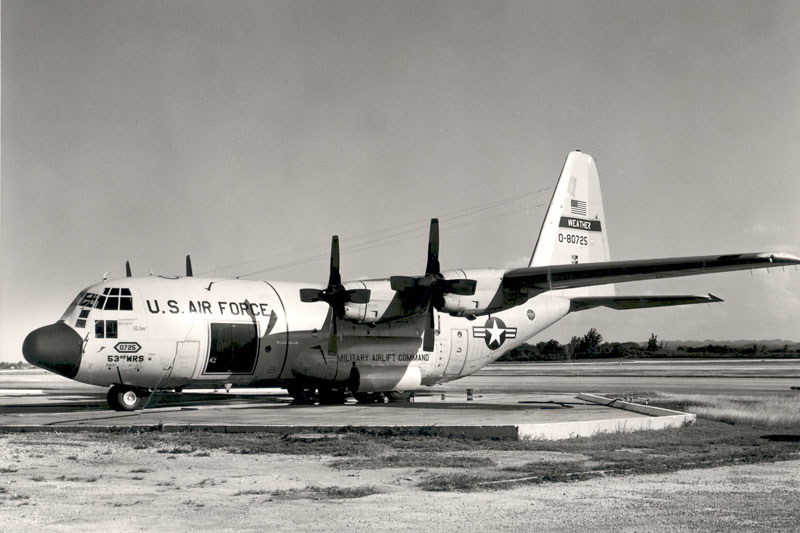 |
| WC-130B
58-0725 with Side-Looking Radar installed in place of cargo door Official USAF Photograph Courtesy of Air Force Weather History Office |
|
In an effort to improve the radar capability of the WC-130s, 58-0725 (along with 62-3495) received a prototype forward-looking weather radar in 1972. Additionally, 58-0725 received a prototype side-looking weather radar, installed where the forward cargo door had been. This aircraft was conspicuous by a large black panel on the port fuselage just forward of the wing. The performance of both radar sets was considered unsatisfactory, but the cost to develop a new system was prohibitive. The C-130's standard search radar has been upgraded over the years, however, and is apparently sufficient for the weather mission. All the 1958 B-models were painted in the standard MAC light gray with full color markings. NOAA's Ark was painted white over gray with a blue cheat line while serving with NOAA, and carried the appropriate civil registrations and NOAA symbols. The 1958 B-models enjoyed only a short tour with AWS. By 1973 the Air Force had approved the swap of all WC-130Bs (including the five 1962 models) for 15 HC-130Hs from the Aerospace Rescue and Recovery Service (ARRS). The B-models were gradually de-modified to trash haulers and found new homes in Air National Guard and Air Force Reserve units. By the 1990s, most of them had been sold to foreign governments, except 58-0729 and 58-0740. 729 has been reduced to beer cans and razor blades. 740, as was noted earlier, was severely damaged at Homestead AFB during Hurricane Andrew in 1992, but the fuselage was salvaged for use as a loading trainer. |
THE H-MODELS
| LOCKHEED C/N | USAF S/N | WHERE IS IT NOW? |
| 4088 | 64-14861 | 105th AS, Nashville, TN |
| 4099 | 64-14866 | 159 FS, Jacksonville, FL |
| 4103 | 65-0963 | 105th AS, Nashville, TN |
| 4104 | 65-0964 | Now HC-130P w/ 79th RQS |
| 4106 | 65-0965 | Disappeared in the South China Sea, 12Oct74 7 |
| 4107 | 65-0966 | 105th AS, Nashville, TN |
| 4108 | 65-0967 | 122 FS, Louisiana Ang |
| 4110 | 65-0968 | 105th AS, Nashville, TN |
| 4111 | 65-0969 | CFB Trenton, Ontario; ground trainer, a/o Aug 2000 |
| 4120 | 65-0972 | Retired to AMARC Dec 1997 (CF 183); no outer wings |
| 4126 | 65-0976 | Now HC-130P, w/ 39th RQS |
| 4127 | 65-0977 | 39 RQS, Patrick, FL |
| 4132 | 65-0980 |
105th AS, Nashville, TN |
| 4139 | 65-0984 |
105th AS, Nashville, TN |
| 4140 | 65-0985 |
157 FS,
So. Carolina ANG |
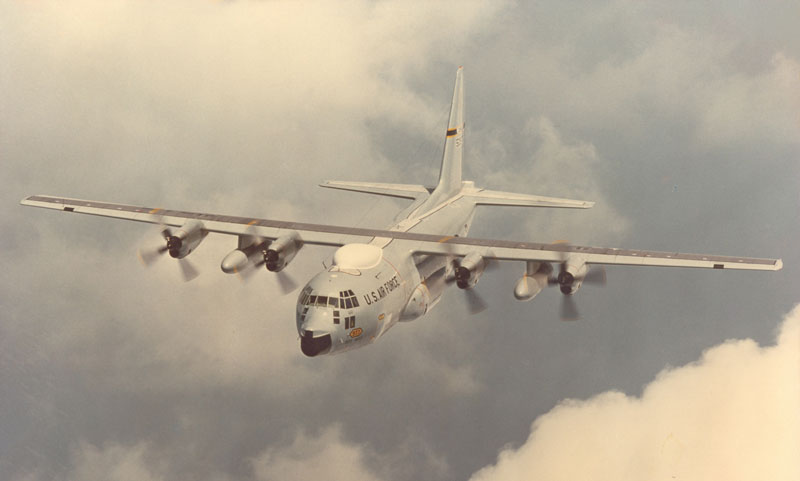 |
| WC-130H
65-0977of the 55th WRS taken over Lake Tahoe, NV Official USAF Photograph Courtesy of Air Force Weather History Office |
|
As mentioned previously, 15 HC-130H aircraft of the ARRS were made available to AWS in 1972. (Although designated as H-models, they were actually E-model airframes with upgraded engines.) Eleven were converted to WC-130H and delivered between June 1973 and July 1974. Four more were modified in 1975. All were modified with the Project Seek Cloud equipment; none were configured for air sampling. They all retained the dorsal radome for several years, though it appears that vestige is now gone from the fleet, and all still sport the angular nose radome of the rescue-type, though all rescue gear has been removed. In 1983, NOAA contracted with Tracor, Inc., for $2.4 million for development of two prototype Improved Weather Reconnaissance Systems (IWRS, also known as "I-Wars").8 USAF contributed about a third of the money. WC-130H 65-0968 received a prototype IWRS in 1985. Three years of operational testing and evaluation followed, whence the remainder of the WC-130 fleet was equipped with the production version. All WC-130s still carry this reconnaissance data system. In 1998, however, the Omega Dropwindsonde system, which was based on the Omega navigation network, was replaced with AVAPS (Airborne Vertical Atmospheric Profiling System), developed by the National Center for Atmospheric Research (NCAR). This system utilizes lightweight digital radiosondes and GPS for positioning and windfinding. |
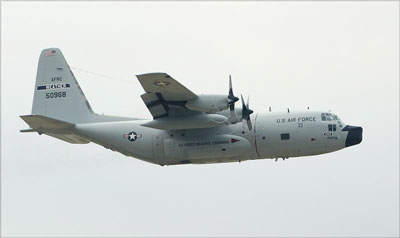 |
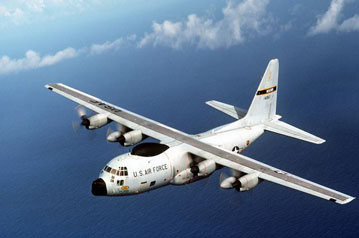 |
| WC-130H
65-0968 and 64-14861 Official USAF Photographs Courtesy of Air Force Weather History Office |
|
| Color schemes on the H-model have varied over the years. The standard light gray with full color markings is the norm. Most had the dorsal radome painted white, though some have been seen with a black radome at times. Four that had been converted to "trash-hauler" with the 815th in 1990 were painted in the "lizard" camouflage scheme, and remained in that cloak for some time after re-conversion to WC-130 in 1993. As this is written, the H-models have all been transferred to other units, and the 53rd WRS has fully converted to the new WC-130J. The last WC-130H left Keesler AFB in January 2006, ending a 32+ year run for this weather reconnaissance workhorse. |
THE J-MODELS
| LOCKHEED C/N | USAF S/N | WHERE IS IT NOW? |
| 5451 | 96-5300 | 53rd WRS; delivered April 2004 |
| 5452 | 96-5301 | 53rd WRS; delivered 11 October 1999 |
| 5453 | 96-5302 | 53rd WRS; delivered October 2003 |
| 5473 | 97-5303 | 53rd WRS; delivered 29 October 1999 |
| 5474 | 97-5304 | 53rd WRS; delivered 15 November 1999 |
| 5475 | 97-5305 | 53rd WRS, delivered April 2002 |
| 5476 | 97-5306 | 53rd WRS, delivered June 2002 |
| 5486 | 98-5307 | 53rd WRS; delivered 6 December 1999 |
| 5487 | 98-5308 | 53rd WRS; delivered August 2003 |
| 5501 | 99-5309 | 53rd WRS, delivery date unknown |
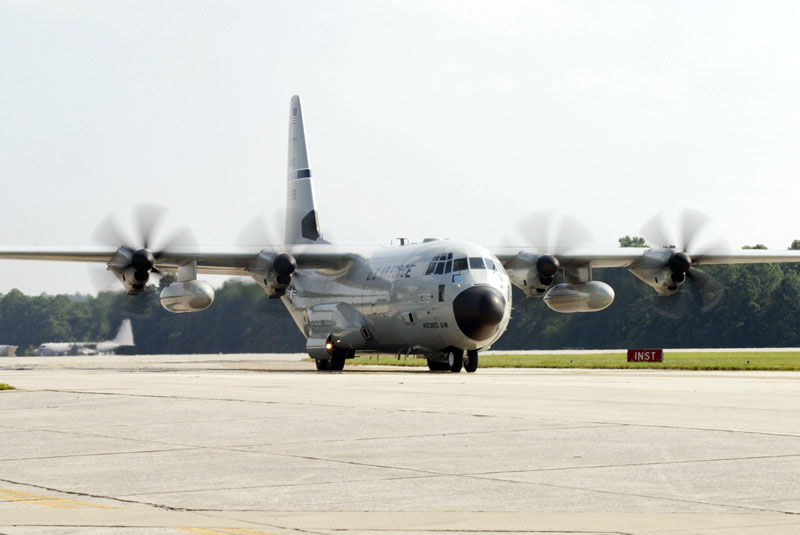 |
| WC-130J
99-5309 of the 53rd WRS (AFRC) Official USAF Photograph Courtesy of Air Force Web Site News Release |
| In
August, 1992, Hurricane Andrew devastated south Florida, and sent
another wake-up
call to Congress. In their wisdom, they determined that the WC-130
fleet had become a
little long in the tooth. Despite deep cuts in the defense budget,
funding was
appropriated for ten new WC-130Js (at roughly $60-million each), and
Congress has mandated
that the 53rd WRS continue its mission with the latest in aircraft and
equipment.10
As usual, the 53rd WRS wasted no time in putting their
new birds to work. On 16 Nov
1999, 96-5301 made fourteen penetrations of Hurricane Lennie during a
14-1/2 hour mission.
All systems, it was reported, were "Alpha-1". As with most new systems,
however,
they take some time to mature. Several issues were identified and
resolved over the course of the next few years and the WC-130J was
declared fully operational prior to the 2005 Atlantic Hurricane Season
and the J-model has flown every operational mission since. Indications are that the WC-130J will be the most capable and sophisticated military aircraft ever dedicated to the weather reconnaissance mission. It will be the mainstay of this country's hurricane reconnaissance fleet through 2030 and probably beyond. The J represents a new era in hurricane reconnaissance, and a new commitment by the government to provide the best technology available for the "Riders On The Storm". As this is written, all ten J-models have been delivered from Lockheed. 11 |
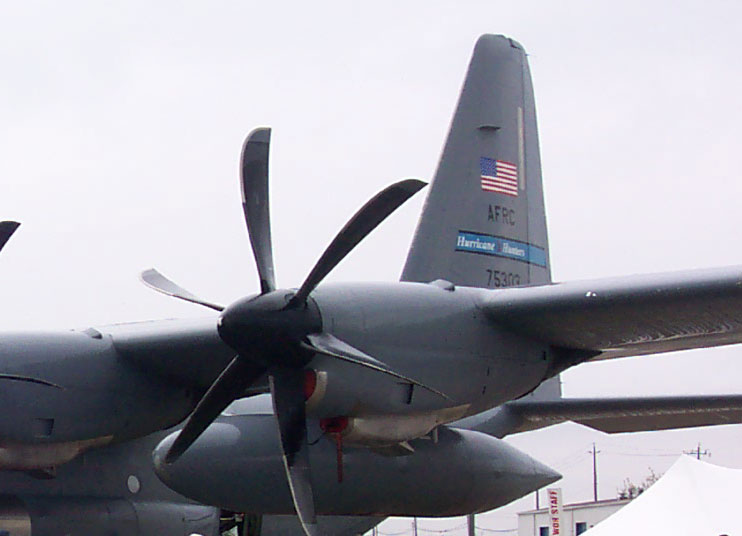 |
| 53
WRS WC-130J on display at the 2006 "Wings Over Houston" Air Show Clearly shows the 6-blade propellor of the J-Model with protective "taco" on the leading edge Also shows the new "Hurricane Hunters" tail flash that will be added to all WC-130Js 2006 Photograph Courtesy of Bernie Barris. All rights reserved. |
Snoopy
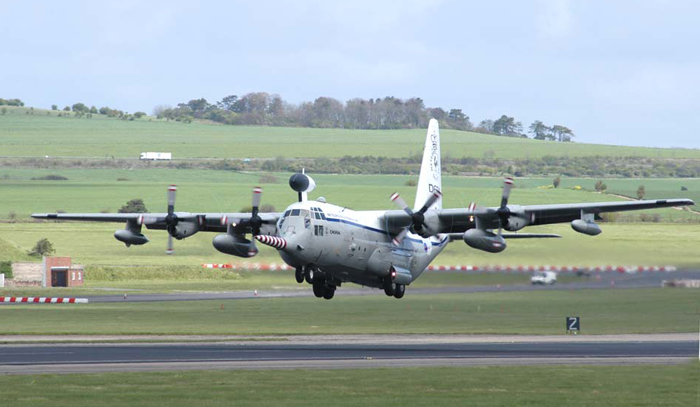 |
| I would be remiss if I didn't mention that there was at least one other "WC-130" operating in the world. That would be the U.K.'s Snoopy, Lockheed c/n 4233, originally an RAF C-130K. It was re-designated Hercules W. Mk 2 and modified for weather research with an 18-ft instrumentation boom protruding from the nose. This necessitated that the radar antenna be relocated to a pod attached to a pedestal above the cockpit. Surely this is one of the most unusual of all C-130 variants, and possibly the most photographed. Alas, the RAF retired Snoopy on 31 Mar 2001. |
|
This history could not have been written without Lars Olausson's Lockheed Hercules Production List, published every year by the world's premier Herky Nut; BOOKS:
PERIODICALS and MAGAZINE ARTICLES:
WEB SITES:
PERSONAL CORRESPONDENCE:
|
ABOUT THE AUTHOR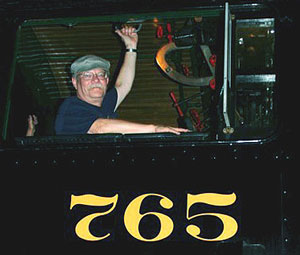 Tom Robison
Tom Robison Born
and raised in northeastern Indiana. Graduated high school in 1966,
attended
Purdue University for two years, then joined the Air Force. After an
interminable Met/ARE tech school at Chanute, reported to the 55th
Weather Recon
Sq. at McClellan AFB, CA. Served there a year, then reported to the
54th
Weather Recon Sq. at Andersen AFB, Guam. Reached the end of my tour on Guam in December 1971, and, as I had less than six months to go on my enlistment, was granted an "early-out". Returned home in January 1972, eager to resume civilian life. In
addition to authoring this tome on the WC-130, I am also the proud
photographer
of the cover photo on Otha Spencer's, Flying
The Weather. By
profession I am an electronics technician. In addition to military and
aircraft
history, my hobbies include photography, building scale models, model
railroading, electronics, and the third love of my life, Nickel Plate
Road steam
locomotive #765 . http://www.765.org/ This document is as accurate as I can make it using the published sources available to me. Comments, suggestions, additions and corrections are encouraged. Contact the author at: herkynut@yahoo.com |
Go to Top of Page

